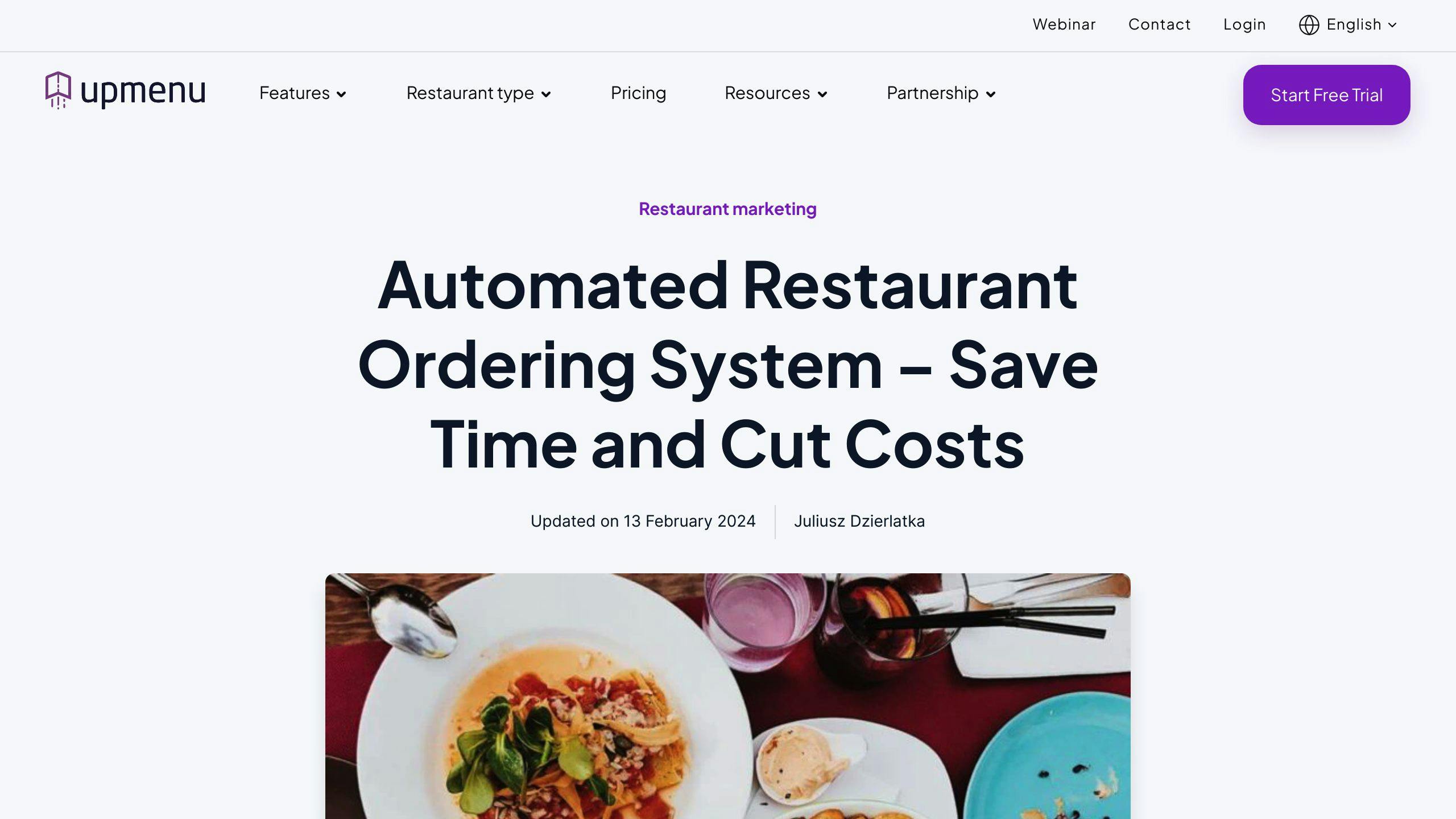June 13, 2024

Getting orders right is crucial for restaurant success. Incorrect orders lead to unhappy customers, negative reviews, and wasted costs. Here are 10 effective ways to boost order accuracy:
- Set clear expectations and provide feedback
- Recognize good work to reinforce positive behavior
- Employees take pride and ownership in their tasks
By implementing these strategies, restaurants can reduce mistakes, keep customers happy, and boost revenue through improved order accuracy.

Using automated order systems can help reduce mistakes. These systems allow customers to place orders through kiosks, apps, or websites, removing the chance of human error.
Many technology providers offer automated order systems that are easy to set up. Restaurants can choose simple digital menus or more complex systems that connect to their existing systems.
Automated order systems take orders directly from customers and send them to the kitchen. This cuts out miscommunication and misunderstandings, leading to higher accuracy.
These systems can lower labor costs since fewer staff are needed to take orders. They also reduce food waste and costs from remaking incorrect orders.
With automated ordering, staff can focus on providing great service instead of routine tasks.
Automated OrderingTraditional OrderingFewer mistakesHigher error rateLower labor costsMore staff neededLess food wasteMore remakesStaff focused on serviceStaff busy taking orders
Automated order systems are an effective way to boost accuracy while saving money and improving the customer experience. Next, we'll look at training staff on order accuracy protocols.
Training staff on order accuracy protocols is straightforward. It involves:
Hands-on practice and role-playing during training help reinforce the protocols.
Proper training significantly improves order accuracy. Well-trained staff:
Consistent training develops habits that minimize errors, leading to higher customer satisfaction.
While training requires an upfront investment, it pays off through:
The long-term savings from improved accuracy can outweigh the initial training costs.
Comprehensive training:
Engaged employees are more likely to follow protocols diligently, driving better order accuracy.
Tracking order accuracy rates is simple. You can use data from your:
Set up a system to track order accuracy. This lets you identify areas for improvement and make data-driven decisions.
Analytics provide insights into common errors, trends, and patterns. By analyzing data on incorrect orders, you can find the root causes of mistakes and fix them.
For example, if data shows a menu item is often wrong, you can:
Using order accuracy analytics can save you money by:
By finding inefficiencies, you can streamline operations and allocate resources better. Analytics can also help reduce labor costs by optimizing staff schedules and workflows.
Analytics give employees actionable insights to improve their performance. By setting targets and tracking progress, they can:
This leads to increased motivation, job satisfaction, and accountability among staff.
Order Accuracy AnalyticsBenefitsEasy to set upUse existing tools and dataImproves accuracyIdentify and fix common errorsSaves moneyReduce waste, optimize inventory and laborEngages employeesMotivates staff to meet targets
Setting up integrated technology solutions is straightforward, especially with cloud-based systems. With minimal setup and training, your staff can quickly start using the new system, reducing downtime and boosting efficiency.
Integrated technology solutions can significantly enhance order accuracy by automating processes and providing real-time updates. For example, a kitchen display system can receive orders directly from the POS system, eliminating manual entry and reducing errors.
Manual Order EntryIntegrated SystemHigher risk of errorsAutomated processesPotential delaysReal-time updatesInefficient workflowStreamlined operations
By streamlining processes and reducing errors, integrated technology solutions help restaurants save money on:
These solutions also provide valuable insights into sales trends and customer behavior, enabling data-driven decisions and optimized operations.
Integrated technology solutions equip employees with the tools they need to succeed. With access to real-time data and automated processes, employees can focus on providing excellent customer service instead of manual tasks. This can lead to:
Clarifying and verifying orders is a straightforward process. You can set up an automated order confirmation email or text message that sends to customers after they place an order. This confirms the order and allows them to review and correct any mistakes.
Verifying orders significantly reduces errors. By double-checking orders, you ensure the correct items are prepared and delivered. This can be done by repeating orders back to guests or using a POS system to streamline orders.
Clarifying and verifying orders leads to cost savings:
Verifying orders also helps identify pricing or inventory discrepancies, allowing you to make adjustments.
When orders are accurate, employees can focus on delivering excellent service, leading to:
Clarifying and Verifying OrdersBenefitsSimple processAutomated confirmation emails/textsImproves accuracyDouble-checking orders, using POS systemsCost-effectiveReduces waste, optimizes operationsEnhances customer serviceAllows staff to focus on service quality
Having the right number of staff during peak hours is key to getting orders right. By tracking order volumes, you can optimize schedules to match staffing levels with busy times. This helps prevent mistakes and delays, keeping customers happy.
Using your online ordering system, you can monitor order trends in real-time. This data allows you to adjust schedules accordingly, ensuring proper staffing without over- or under-scheduling.
With the right staffing during rushes, you reduce the risk of errors and delays. Employees have more manageable workloads, leading to higher accuracy and better service.
Proper StaffingUnderstaffingLower error ratesMore mistakesFaster serviceLonger wait timesHappier customersFrustrated customers
Optimized schedules cut labor costs by avoiding overstaffing. You also waste less food by reducing inaccurate orders that need remaking.
Balanced workloads prevent burnout and stress. Employees feel more satisfied and motivated when not overwhelmed during peak periods.
Balanced WorkloadsExcessive WorkloadsHigher job satisfactionIncreased stressMore motivationHigher burnout riskBetter focusMore mistakes
Rewarding employees for accurate orders can motivate them to focus on getting orders right. Here's how it works:
Studies show incentives can increase employee performance by up to 44%. Rewarding accuracy:
While rewards cost money upfront, they save you from:
The long-term savings often outweigh the cost of incentives.
Recognizing accurate orders makes employees feel valued, leading to:
With IncentivesWithout IncentivesHigher accuracy ratesMore errorsMotivated employeesDisengaged staffCost savingsWasted resources
Rewarding accuracy is a simple yet effective way to improve order quality while keeping employees engaged and motivated.
Streamlining order processes can reduce errors and confusion. Here's how:
Streamlined processes minimize opportunities for mistakes by:
This leads to fewer miscommunications and errors.
More efficient processes save money by:
Clear, consistent processes are easier for staff to learn and follow, ensuring:
Streamlining order processes creates a smooth, error-free workflow from order to delivery.
Good inventory management makes it easier to get orders right, since you'll always know exactly what products you have in stock. Here's how to improve inventory management:
Knowing your inventory levels prevents overselling and ensures orders are fulfilled correctly. This reduces mistakes like shipping the wrong item or quantity, which can lead to unhappy customers.
Proper inventory management:
Providing the right inventory tools and training empowers employees to:
Good Inventory ManagementBenefitsEasy to implementReview processes, organize stock, use softwareBoosts accuracyPrevents overselling and shipping errorsCost-effectiveMinimizes waste, reduces inventory costsEngages employeesImproves job satisfaction and productivity
Predictive analytics can help get orders right by analyzing customer behavior, preferences, and ordering patterns. This allows restaurants to anticipate demand, manage inventory levels, and automate ordering processes.
Integrating order management systems with data analytics tools enables predictive analytics. This allows restaurants to collect and analyze data on:
With the right tools and training, staff can easily use predictive analytics to make informed decisions.
Predictive analytics reduces errors in ordering and inventory management by:
This leads to increased accuracy in fulfilling orders and improved customer satisfaction.
Predictive analytics helps restaurants:
By anticipating demand and adjusting inventory, restaurants can avoid overstocking and reduce waste, leading to cost savings and improved profitability.
Predictive AnalyticsBenefitsEasy to implementIntegrate order and analytics systemsImproves accuracyAnalyze customer data, anticipate demandCost savingsMinimize waste, optimize inventory
Creating a culture where employees take responsibility for their work is key to improving order accuracy. When staff feel accountable, they are more likely to double-check orders and take pride in their tasks.
Building a culture of responsibility is straightforward:
These steps can be implemented through team meetings, one-on-one check-ins, and performance reviews.
When employees feel responsible for their work, order accuracy improves because:
Culture of ResponsibilityBenefitsClear expectationsEmployees know what's expectedRegular feedbackOpportunities to improveRecognitionMotivation to perform well
A culture of responsibility leads to more engaged and motivated staff because:
Getting orders right is crucial for restaurants to succeed. By using the 10 strategies below, you can reduce mistakes, keep customers happy, and boost revenue:
1. Use Automated Order Systems
Let customers place orders through apps or kiosks. This cuts out human error and miscommunication.
2. Train Staff on Order Accuracy Protocols
Teach staff how to:
Well-trained staff make fewer mistakes.
3. Use Order Accuracy Analytics
Track data on incorrect orders to find and fix common errors. Analytics help:
4. Use Integrated Technology Solutions
Cloud-based systems automate processes and provide real-time updates, reducing manual errors.
5. Clarify and Verify Orders
Send automated order confirmations so customers can review and correct mistakes.
6. Schedule Smarter Shifts
Match staffing levels to peak hours to prevent errors and delays.
7. Reward Employees for Accurate Orders
Offer bonuses or prizes for meeting accuracy targets. Incentives motivate staff to double-check orders.
8. Streamline Order Processes
Review order flow and remove bottlenecks or redundant steps. Streamlined processes mean fewer mistakes.
9. Improve Inventory Management
Use barcodes and software to track stock levels. Good inventory management prevents overselling and shipping errors.
10. Build a Culture of Responsibility
Set clear expectations, provide feedback, and recognize good work. When staff feel accountable, they take pride in getting orders right.

Enter your information in the form to receive a call from Loman and place an order like a customer would!